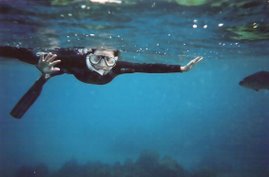 above: kid next to the "door of no return" (which slaves passed through to leave their home forever) at Changuu Island, Zanzibar
above: kid next to the "door of no return" (which slaves passed through to leave their home forever) at Changuu Island, Zanzibar

dhows anchored at Stone Town, Zanzibar

twilight over Stone Town

aerial of the reef around Unguja island, Zanzibar

hallway at Beit-Al-Amaan ("house of peace")

chillin at Beit-al-Amaan's lush living room
Zanzibar.
Ahh… hearing the name alone makes people feel like they’re on an exotic tropical island. It needs no other embellishment.
Apparently the name was originally “Zangh Bar,” which means “Coast of the dark people” or “Negro Coast” in Arabic. For centuries Arabic colonizers and merchants used it as a base for its Indian Ocean slave trade. It’s a bit more racist and less romantic when you know that, eh?
The rest of Team Tanzania (the guys who are part of the crew from my department at UCSF who come to Tanzania regularly) was exuberant and happy that we were finally on a holiday in Zanzibar. Everyone loves Zanzibar. Even John and Royce, who were already back in San Francisco, were ecstatic for us. They all knew that we had worked hard and felt wasted.
Who wouldn’t love being in a gorgeous coastal environment with the richness of blended African, Arab and Indian cultures?
Zanzibar is gorgeous and lush. It still has intact, healthy coral reef full of fish around the islands other than Unguja, where Stone Town is.
But there is an element of Havana, Cuba in it. The concept of a former bastion of ill-gotten wealth which fell into chaos and redistribution. But unlike Havana, the new Zanzibari government was not very organized about the redistribution of land and buildings. Stone Town was previously a wealthy slave and ivory trading port, built on the backs and blood of black Africans from the interior. Countless black Africans were killed in the process. After centuries of slavery, there was an uprising by black African askaris (soldiers) in the 1960s which killed off nearly 20,000 Arabs. Since there had been quite a bit of intermarrying, it was probably quite arbitrary who got selected for murder – perhaps the lighter-skinned people, perhaps the people who owned more stuff. People say that Zanzibar is now a happy blend of people, but I wonder how much of this is the sheen sold to tourists like me.
By the end of my two months in Tanzania, I was happy to wander the alleyways of Stone Town with just my compass guiding me… and enjoy the warmth of the Indian Ocean and the living beings in it. But I am very ready to go home to San Francisco.
And I am happy that I did not decide to live abroad semi-permanently for my next job.
I would be a terrible expatriate. I don’t enjoy any part of that culture: creating insular little communities, living in a gated house with a house-girl and askari, driving around in a hulking SUV, having others cook and clean for me, going out to bars with the other ex-pats – most of whom drink and smoke and generally do nasty things, especially to the people native to the community (i.e the black folks). It is an obnoxious and unmindful lifestyle.
If I move to a place like Moshi or Tabora or Kisumu, I might try to make better friends among my black colleagues, but I could never really be integrated into their communities. There would be too many barriers from both sides. There are some ex-pats, especially the white people, who say they have good Tanzanian friends, but on closer inspection, theirs is really a paternalistic relationship – the ex-pats “buy off” their “friends” by giving them CD players, extra money, nice dinners at restaurants, scholarships. I cannot build friendships in this way. It’s just not balanced or sincere when it is clouded by favors.
It has become clear to me that I travel to East Africa really to work and build better HIV/AIDS care – not for vacation, not for the love of being an ex-pat, not for the lifestyle. Of course, there is the special-ness and challenge of working in a totally different culture from my own. But the magic veil of “otherness” wore off early on, when the reality of the work, of the sick and dying patients, set in. My skills and training have value here, if I use them well.
So – I am happy to return to my own “native” community in the Bay Area. This is where my partner and my family are, where I am building a sangha, a community of people who support my practice in being a good person, a person of lovingkindness.
With their support, I can rebuild my strength and resolve to return to Tanzania in July to continue this work.
 above: kid next to the "door of no return" (which slaves passed through to leave their home forever) at Changuu Island, Zanzibar
above: kid next to the "door of no return" (which slaves passed through to leave their home forever) at Changuu Island, Zanzibar





2 comments:
wow beautiful images, the one of the door of no return is very powerful!
like ly said, the images and your writing in this entry is really powerful. i had a physical reaction in my stomach when i saw/read the door of no return. it is amazing to hear your mind at work through your experiences and reflections as expressed through your blog- probably a healthy way to process what you go through in your journeys while you're there...
Post a Comment